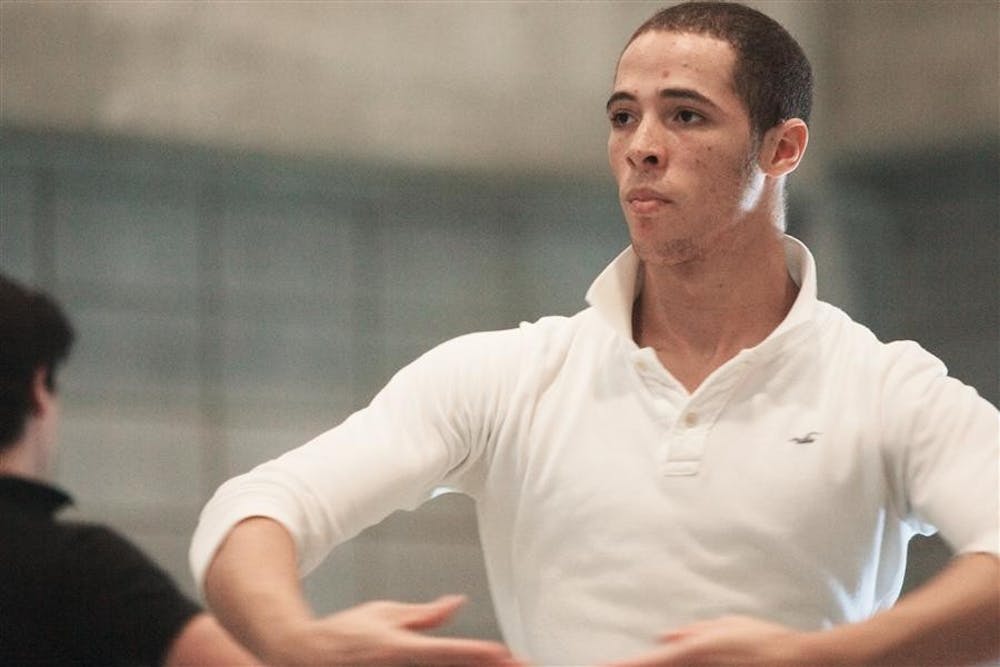Stephanie Lampe unlaces her satin shoes, revealing toes covered in bubbles of calluses and blisters. If a blister breaks open, she puts her foot in salt water. It hurts, but she wants to keep a layer of dead skin to form a new callus.
The shoes she sets aside are pink and elegant but lined with tiny tears and coated with gray dust. They typically cost $50-$70 and rarely last longer than two weeks – sometimes not even two days.
But as a dancer in IU’s ballet department, Lampe is required to dance for hours each day, taking a toll on feet and shoes alike. To appear virtually weightless on stage, her shoes, made mostly of fabric and glue, must be virtually weightless on her feet.
In spite of the pain and the price, ballet is her life.
If you ask someone carrying a French horn case in the basement of the Musical Arts Center where the ballet department is, they probably couldn’t tell you. In a corner on the third floor, ballet majors dance from 11:30 a.m. to 5:45 p.m. in three studios – classes in the morning and rehearsals in the afternoon.
“Sometimes you get a break, sometimes you don’t,” Lampe says.
Lampe grew up just east of Indonesia in Papua New Guinea, where her father worked as a campus pastor. She says she started ballet because in Papua New Guinea, all the little girls danced. Her sister started taking classes at the age of 6. As a 4-year-old, Lampe was too young to take the class, so she watched from the school’s lobby and mimicked the moves from afar.
Today ballet takes up most of her time and she admits she doesn’t have a very active social life. She calls her relationship with her fiancé, John, “a negotiation” because she disappears for hours at a time to dance. She goes to bed every night at 10 p.m. and wakes up every morning at 6 a.m. to do her homework. She likes to bake at least once a week to relieve stress. She makes whole wheat bread, coffee cake, cookies, pies, or biscuits, depending on what she has in her kitchen.
As a senior, she’s working on her DVD resume to send out to professional dance companies – common among ballet majors. But she came to IU so she could have a backup plan, a double major in math – disciplined thinking to go with the disciplined movements of her body. She likes math because it gives her the opportunity to sit and be absolutely still.
About 90 percent of graduates from IU’s ballet program find places in professional ballet companies. Don’t tell anyone, but freshman Anton LaMon doesn’t want to be in a professional ballet company. He sees himself in musical theater on Broadway, but hopes his formal ballet training will give him an advantage.
“A guy who can dance is gold,” he says.
LaMon is one of 10 men in this year’s ballet program of 40 students. He began jazz and tap dance when he was 3 years old, and he was on the dance team in middle school. Being a male dancer at that age was tough because, as he says, “people talk.” He quit dancing because he didn’t want anyone to think he was gay. After three years without dance, he knew something was missing.
“I just had to dance,” he says.
LaMon attended Bloomington High School South and received formal ballet training in the pre-college program at IU taught by ballet majors, convincing him to come to IU for ballet. Once he started college, he admitted to himself, and everyone else, that he was gay.
“I came out,” he says. “I don’t have anything to hide.”
Because there are only 10 men in the department, most of the male roles in IU Ballet Theater productions get cycled around, so taking time off or getting injured aren’t options. LaMon wishes he could trade majors with another student for just one day.
“I don’t really know what happens during the day on campus.”
He does a lot of jumping and suffers from shin splits. In spite of the pain, he likes having rules that govern the movement of the body. For LaMon, ballet is clean and flawless. He likes being part of a story on stage.
“The moment I perform, I know I made the right choice.”
Lauren Fadeley hates telling people that she’s a ballet major. She’s afraid most people don’t see it as a “real” major. But Fadeley, a senior, was a “real” dancer in the New York City Ballet when she was 16. She achieved her life dream before graduating high school.
Fadeley moved to New York City by herself at age 15 to attend boarding school at the School of American Ballet. The ballet selects students from the school every year to join its company. Fadeley didn’t have to audition – she was chosen.
Being a professional dancer gave her everything she wanted, but she felt lost in the huge company of nearly 100 dancers. And her schedule was draining. She would go to school in the morning then dance until 10 p.m. Dancing was her job.
Monday was her only day off and she spent it in class trying to finish her high school degree. The company wasn’t sympathetic when she needed time off to take the SATs. A lot of professional dancers never graduate from high school.
And then there was the pressure to be really thin. Ballet dancers spend all day in a room with mirrors wearing leotards and tights. The body line is important. Whenever Fadeley had a break from dancing, she was at the gym. She saw a lot of dancers with eating disorders. Some would smoke to keep their weight down.
“Management would tell people ‘You need to lose weight or you won’t be on stage,’” she says. “They told me to lose weight when I was injured.”
But at 17, Fadley broke her foot dancing and it suddenly sank in — ballet wasn’t permanent. She was unprepared for life beyond the stage. The average retirement age of a ballet dancer is between 35 and 40 years old.
“You hit 35 and that’s it,” Fadeley says.
So after two years of performing professionally, she came to IU. When IU Ballet Theater dancers perform “The Nutcracker,” there are four shows. The NYCB performs 60. The university setting allows Fadley to continue dancing while getting an education. She wants to help dancers as a physical therapist after she graduates.
Dancers constantly PUSH their bodies physical limit as every muscle must be used in exactly the right way. If a dancer is performing on a stress fracture, she can’t limp out of character. Some dancers never tell anyone about their injuries and hold the pain inside. Doricha Sales was one of those dancers.
“That’s when you know you have the dancer mentality,” she says.
Sales was a dancer in the Boston Ballet in the mid-’80s. She came to IU’s ballet program in 1990, where she says she matured as an artist. She later danced with the Florida Dance Theater. Her ankle hurt, but she never went to the doctor, and one day during rehearsal the tendon in her ankle snapped.
“I felt it pop and tear,” Sales says. “Then I had to go to the doctor.”
She had to get surgery and wouldn’t be able to dance for two years. At the age of 24, her professional career had ended.
“Your instrument is your body,” she says. “You have to take care of it.”
She returned to IU to get her master’s in ballet pedagogy and educational psychology. Now Sales, 34, is an academic adviser in the ballet department at IU, where she helps the next generation of dancers function in an environment she says is just like a ballet company.
Outside her office, ballet majors sit in the hall between rehearsals inspecting their blisters and unlacing worn out pointe shoes.
“You have to be proud of every single one of these dancers,” she says.
Blisters & Big Dreams
In a department where simply being accepted is an accomplishment, IU’s ballet students share the ugly side of a beautiful dance

Get stories like this in your inbox
Subscribe





